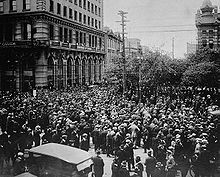- One Big Union (Canada)
-
OBU Full name One Big Union Founded 1919 Date dissolved 1956 Federation merger Canadian Labour Congress Members 40,000-70,000 Country Canada Affiliation Socialist Party of Canada, Syndicalism Key people Robert B. Russell Office location Winnipeg The One Big Union (OBU) was a Canadian syndicalist trade union active primarily in the Western part of the country. It was formally founded in Calgary on June 4, 1919 but lost most members by 1922. It finally merged into the Canadian Labour Congress in 1956.
Contents
Background
Towards the end of World War I, a wave of radicalism swept the labor movement in Western Canada. This led to disputes with both the Trades and Labour Congress of Canada (TLC) and the American Federation of Labor (AFL) on the one hand and the government on the other. Western unions were represented by only 45 of 400 delegates at the September 1918 TLC convention. Their resolutions to condemn Canada's efforts in World War I were therefore easily defeated. Moreover, the socialist TLC president James Watters, who had held this post since 1911, was replaced by the conservative Tom Moore.
This led Western unionists to decide to hold a caucus, which would go into history as the Western Labor Conference, ahead of the 1919 TLC congress. The caucus was dominated by members of the Socialist Party of Canada, who favored a secession from the TLC. The conference passed a resolution condemning the Canadian government's practices during the war and expressing solidarity with the Bolsheviks in Russia and the Spartacists in Germany. It was also decided to poll Canadian workers on a general strike scheduled on June 1.
Rise
The general strike that broke out in Winnipeg on May 15 was organizationally not connected to the OBU. Yet the federal government and conservatives within the labor movement, alike, accused the OBU of having instigated it. Many local leaders including OBU members such as Robert B. Russell were arrested in conjunction with the strike. The One Big Union organized strikes in support of the events in Winnipeg across Western Canada including Vancouver, Calgary, and Edmonton. They all failed, however.
The secession, by what would soon become the OBU, faced resistance from the AFL and the TLC from the very beginning. They were shut out of most local trades councils. Nonetheless, thousands of workers left the AFL and the TLC and joined the OBU. These included loggers, hard rock miners, coal miners, longshoremen, construction workers, metalworkers, shop craft workers, etc. The One Big Union organized along industrial rather than trade lines, in response to a breakdown in craftsmanship (Taylorism) and the burgeoning demand for unskilled labour.[1] The OBU's anti-capitalist stance was evident in its constitution's pre-amble:
The O.B.U. ... seeks to organize the wage worker nor according to craft but according to industry; according to class and class needs; and calls upon all workers irrespective of nationality, sex, or craft to organize into a workers' organization, so that they may be enabled to more successfully carry on the every day fight over wages, hours of work, etc. and prepare themselves for the day when production for profit shall be replaced by production of use.[2]
By late 1919 the OBU's membership reached 40,000 to 70,000. The members were almost exclusively from the west. Efforts to organize in other parts of Canada or in the United States failed.
On June 4, the union was finally officially founded at a small meeting in Calgary. Although an industrial form of organization was chosen, many key questions were left unanswered in the constitution passed at this meeting. The way the OBU operated did not differ much from the AFL or the TLC. Often, AFL or TLC union structures were simply incorporated into the OBU without any change, members simply started paying their dues to a different organization.
Fall
The union's peak was reached in late 1919 or early 1920. With the persecution by the media, government and other unions the membership fell. Employers refused to bargain with the OBU's representatives.[3] By 1921, it had only approximately 5,000 members, by 1927 only 1,600, almost all in Winnipeg. By 1922, most of the union's income came from a lottery it ran in its weekly bulletin. At the time lotteries were illegal in Canada, but it took the authorities years to successfully prosecute the union. The paper had a large circulation because of the lottery, even business leaders bought it cutting out the lottery coupons and throwing away the rest.
In the late 1920s the OBU briefly joined the All-Canadian Congress of Labour and considered joining the Canadian Congress of Labour during World War II, but by then its members were almost all employees of the Winnipeg Transit System. In 1956, the union finally merged into the Canadian Labour Congress.
References
Further Reading
- Bercuson, David Jay (1990), "Syndicalism Sidetracked: Canada's One Big Union", in van der Linden, Marcel; Thorpe, Wayne, Revolutionary Syndicalism: an International Perspective, Aldershot: Scolar Press, pp. 221–236, ISBN 0-85967-815-6
- Warrian, Peter (1971), "M.A. Thesis, University of Waterloo", The Challenge of the One Big Union Movement in Canada 1919-1921, University of Waterloo
Canadian Labour Congress Provincial
FederationsNational
AffiliatesInternational
AffiliatesPresidents Claude Jodoin (1956–1966) · Donald MacDonald (1967–1974) · Joe Morris (1974–1978) · Dennis McDermott (1978–1986) · Shirley Carr (1986–1992) · Bob White (1992–1999) · Ken Georgetti (1999–present)
See Also Canadian Congress of Labour · One Big Union · Trades and Labour Congress · Workers' Unity League · ILCA
Categories:- Trade unions in Canada
- Organizations established in 1919
- 1956 disestablishments
- Canada in the World Wars and Interwar Years
- Canadian Labour Congress
- Syndicalism
- Economy of Winnipeg
- Organizations based in Winnipeg
Wikimedia Foundation. 2010.

